| FLYER ||| FACEBOOK | TWITTER ||| 日本語 |
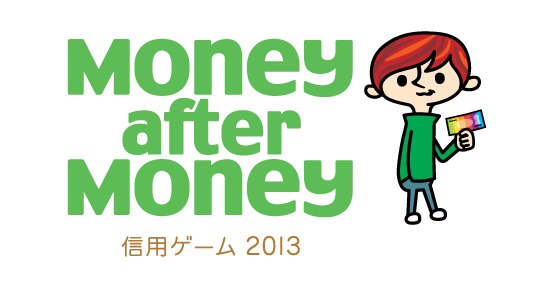
“Money after Money | Credit Game 2013”
In our current world that is connected through a broad digital network, the economy is facing a significant turning point. Right now, “money” is in the middle of being redefined as the energy that gives birth to creative endeavors. From the art works created around 1980 by Andy Warhol and Joseph Beuys, a time when the global economy began to boom; to the works of emerging artists, who are active in the age after the Lehman Shock, “Money after Money | Credit Game 2013” attempts to present a new and fresh view point towards “money.”
Catalogue text
■ An introduction to “Money after Money | Credit Game 2013” by Masu Hiroshi Masuyama
■ The Multiplicity of Money by Hiroo Yamagata
■ Money as “Media” by Ken Suzuki
■ On “Money after Money | Credit Game 2013” by Yukiko Shikata
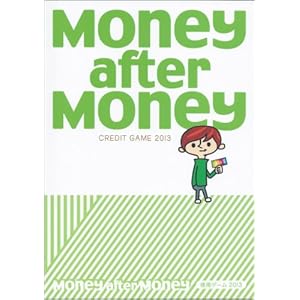
The catalogue of “Money after Money | Credit Game 2013” is available at amazon.co.jp (*In Japanese).
|
DATE: May 2 (Thur) – May 26 (Sun), 2013
HOURS: 11:00a.m. ~ 8:00p.m.
OPENING DAYS: Every Day
ADMISSION: Free
VENUE: EYE OF GYRE (GYRE3F) 5-10-1 Jingu-mae, Shibuya-ku, Tokyo JAPAN
Tel: 03-3498-6990 >>website
Organized by: General Incorporated Associtation MAM
Special Cooperation: JTQ
Cooperation: HiRAO INC
Supported by:Sony Business Solutions Corporation,
Austrian Emabassy/Austrian Cultural Forum, Goethe-Institut Tokyo
Benefactor:Kazuo Kurosawa
Executive Producer: Masu Hiroshi Masuyama
Curator: Yukiko Shikata
Artists:
Julieta Aranda + Anton Vidokle / Joseph Beuys / exonemo / Philip Haas / Ellie Harrison / Christin Lahr / Nitipak Samsen / UBERMORGEN.COM / Andy Warhol

exonemo《MoneyFinder Harajuku》(2013)
“MaM Special Project”
EXONEMO×MaM×GYRE 《MoneyFinder Harajuku》
DATE: May 11 (Sat)~ 26 (Sun), 2013
HOURS: 11:00a.m. ~ 8:00p.m.
VENUE: GYRE and area around
>>website
|
exonemo “MoneyFinder Harajuku” (2013)
*iPhone app. + workshop by using the app. in and around GYRE.
The purpose of this game is to walk outside and use the app’s map to pinpoint and find virtual money, or “MaM” *, that is scattered around in different places. After collecting MaM and making it your own, those playing the game can “bury” it in a new place for others to find. When you find and collect MaM, a real time video of yourself is sent to the player who buried MaM,and thus the player who buried MaM can see who found and collected it. In other words, in exchange for showing yourself, you can receive MaM. In exchange for your MaM, you can see who is receiving it. Take this app, go outside, and try out this communication game. (exonemo)
*”MaM” is the virtual money used for the game, made in accordance with the exhibition. “MaM” does not have any real currency value.
|
“MaM Talk & Music Live”
DATE:May 11 (Sat) 3:00p.m. – 7:00p.m.
Entrance Free (limited 50 sheeting)
VENUE:Lapin et Halot (Omotesando)
5-44-2 Jingu-mae, Shibuya-ku, Tokyo Japan >>website
3:30p.m. – 5:30p.m. Talk: exonemo (artist), Seki Obata (Associate Professor of Keio Business School), Kazuhiko Hachiya (Artist), Masu Hiroshi Masuyama (Executive Producer of MaM), Yukiko Shikata (Curator of MaM)
6:00p.m. – 6:45p.m. Live: mishmash*Julie Watai

UBERMORGEN.COM “Everything is Always” (2013)
http://www.ubermorgen.com/
Displayed are images of half of an apple, cut horizontally, and half of an apple, cut vertically. Beside these is a diagram with everyday things and what they equal; equivalencies not considered before. “Forbidden Fruits” of Adam & Eve (even not exactly identified as Apple), Beatles’ record label, Apple Computer… UBERMORGEN.COM demonstrates that an apple can be viewed in many different ways, thus making it not neutral but with many meanings, good and bad. They continues: “the one who has money gets more money, the one who has not gets none.” With the acceleration of derivative transactions, “Everything is Always” seeks a vision of how humanistic information posted on a high-speed digital network will lead to the reconstruction of future. 1/9000 of an orgasm equals 1/100000 of cocaine equals1/5400 of an apple’s value, 1/400 of a toothbrush equals 1/10 of a breath or 1/100000000 of cloud power. In the world of “everything is always”, a value of money can shift and turn to hold different forms of the same value beyond services, goods, and feelings, and continuously being exchanged at random in a continuous loop, beyond human wishes and needs. Everything is related to one another, and value can be born at each time in circulation. This concept differs from how the existing economic system is viewed, and brings to light an alternative outlook of the world in terms of how “money” and “value” are considered. (YS)
|
|
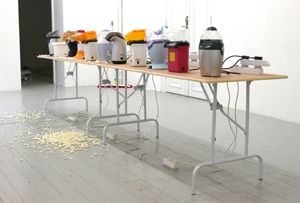
Ellie Harrison “The History of Financial Crises” (2009)
http://www.ellieharrison.com/
The eleven popcorn makers are an artistic display representing the past eleven financial crises in the past one-hundred years This last century is represented by the hours of the exhibition, during which each machine automatically generates an outburst of popcorn according to when that specific crisis occurred in the one-hundred years. Many of the popcorn makers become active in the later hours of the exhibition, demonstrating that most of the financial crises of the past one-hundred years occurred in the only the last twenty years. The first half of the century welcomed booming globalization, the second half brought about a society of consumerism, and now the era of the Internet has opened up unlimited virtual opportunities for speculation, making our current world a “financial crises-producing machine.” Ellie Harrison takes the serious subject of financial crises and creates a display that can be seen and experienced, a physical commentary presented with a humorous effect. Taste it, go ahead and stuff your cheeks. (YS)
|
|
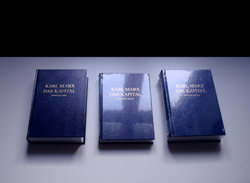
Christin Lahr “MACHT GESCHENKE: Das Kapital” (2009- c. 2052)
http://www.macht-geschenke.de/
Since May 31th, 2009, Christin Lahr has been transferring 1 cent every day to the German Federal Ministry of Finance through a bank transfer online. Each time, when writing the “reason for payment”, Karl Marx’s “Capital — A Critique of Political Economy” is sent from the beginning in the allowed 108 characters at a time. In 43 years,15,709 cents and 1,696,500 characters (the entire book) will be transferred to the German State through the Federal Bank. This project is an every-day “donation” to the national government; however, since this amount of money will create a surplus to the national capital of Germany, the unexpected addition to the national budget will disrupt the balance sheet. The federal government will either have to return the money or create a special account just for the use of this project, or else balancing income and expenditures of the national budget will be made impossible. Christin Lahr deems her project to be “a gift, in the form of an every-day action of making a bank deposit in the Internet.” (YS)
*The text is excerpt from the first half of catalogue text.
|
|

Nitipak Samsen《TRAIL$》(2010)
http://www.dotmancando.info/
In this short fictional film, a successful entrepreneur who used to work for the “Ministry of Finance” is depicted recording a series of videos explaining his experience with a new currency system developed in the year 2020. In order to reduce money laundering and other crimes, a new “smart money” shows the previous six owners of the currency, giving the money a personal history or stream of how the money was passed. As the film progresses, the tension of the man increases. He left the“Ministry of Finance”, a place where he was involved in developing this new currency, when he received a note in which the first of the six owners was a drug dealer. Because he received this note in his salary, the next five owners were departments of the Ministry of Finance. This man realizes the Ministry of Finance created this new currency so that instead of private bribing occurring in society, only the Ministry could receive bribery money. After resigning, the man starts a business in which he sells notes in which a famous individual was the previous owner for a much higher price than the note’s value. Soon, the Ministry of Finance claims the man is causing inflation, and when he blackmails the Ministry with the note that shows the drug dealer bribed the Ministry, a series of threats ensues. Once viewing the last scene, the audience realizes that in the very first image of the film, the man is shown lying at his desk, dead.
”TRAIL$” offers a view on a dystopia that demonstrates the complications that the digital world creates in which discerning good and evil is difficult. The work may also be viewed as a parable for how even now, the personal history of each individuals’ actions are many times recorded into a digital database. (YS/MHM)
|
|
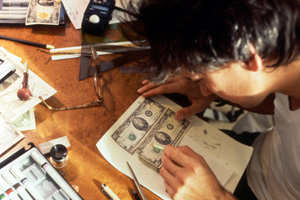
Philip Haas “Money Man” (1992)
Courtesy of Milestone Film & Video
This documentary follows J.S.G Boggs, an artist in the United States of America who draws elaborate dollar bills (from $1 to $1000), signs them himself, and uses them in transactions. At cafes, hotels, and stores, Boggs presents his notes (his artwork) and explains their worth, hoping to negotiate each person into accepting the note’s worth as valued as much as is written on the bill. Most cases his Boggs notes are not accepted, but occasionally there are people who find interest and accept the notes or even collectors who pay more than their worth. This type of art makes the boundary between counterfeiting and artwork difficult to discern, with the United States Treasury and Secret Service confiscating his notes as forgery, and collectors tracking down the notes and even purchasing the items he bought with Boggs Notes along with the change and receipts he received. Currency made by the United States Treasury is manufactured with many regulations and the value of each bill is fixed. Boggs notes; however, are made freely and change in value depending on the case and who is involved in the transactions. It is said that these experiences of being arrested for counterfeiting and also being able to live off of his Boggs notes are also part of the art performance. (YS/MHM)
|
|
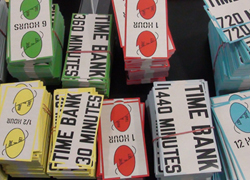
Julieta Aranda + Anton Vidokle “time/bank” (2009-)
Time/Bank currency designed by Lawrence Weiner, Julieta Aranda + Anton Vidokle “time/bank” (2009-) Photo by: Julieta Aranda
http://e-flux.com/timebank/
“Time/Bank” is a platform for an alternative form of economics in which an individual or group’s skills, services, and time are exchanged for another individual or group’s skills, services, and time. Differing from the current system of currency, this platform is based on the advantage of varying types of skills and creative energy that are needed and can be exchanged instead of a straight exchange of currency. This project is said to be an experiment to attempt a type of economics that was marginalized since the Industrial Revolution. This type of exchange is born from bottom-up value, a sort of assisting each other through what each individual or group has as a skill. Through“time/bank,” Aranda and Vidokle opened new cultural and social system to circulate good, services and emotions by utilizing current digital networks. The concept of a time bank is not new. 200 years ago, a man from the United States of America, Robert Owen, attempted an experiment in which he developed a system of using time as an instrument of exchange instead of the existing currency. Inspired by this experiment, Paul Glover began a similar system in Ithaca, New York in 1991. The system is still used today as a local currency to pay for time and is generally accepted by businesses and residents of Ithaca. “time/bank” was shown in the form of exhibition in many cities in the world such as The Haag, Frankfurt, Moscow, Berlin, NYC, and further being continued in some cities by citizens. (YS)
|
|
Joseph Beuys “KUNST = KAPITAL” (1979)
This exhibition displays three artworks by Beuys that demonstrate his saying, “KUNST=KAPITAL (Art = Capital)”. To Beuys,“capital”is the creative power that each person potentially holds within. His vision that art could expand into society to circulate as funds goes beyond the existing system of economics and suggests an alternative value of economy in idea and practice.The fact that Beuys produced many multiples means that he tried to go beyond the mass production and consumer society by creating a new value, Throughout works with vigorous humor and irony, Beuys’vision is still vivid to us now. (YS)
*Excerpt of catalogue text.
|
Andy Warhol “$1” (1982)
Marilyn Monroe, Elvis Presley, Campbell’s Soup labels, and dollar bills…: every day images of 1960s America, an era of mass production and consumer society, are depicted by Andy Warhol. Once Warhol’s studio, “The Factory”, was established in 1962, he took advantage of Marilyn Monroe’s death in August of that year and depicted her in a silkscreen work, making her legacy go beyond her death. Warhol continued repeating the act of using silkscreen in depicting many iconic figures, thus giving them eternal life by freezing as superficial sign with a flavor of death. The work on display, “$1”, where the $ sign is repeated and lined up side by side, was created around 1980, a time when America’s global economy was sweeping over the world. From his hand-drawn dollar bills in the early 1960s to his “$” silkscreen, from the prohibition of duplicating currency to the duplication and spread of the symbol itself, Warhol’s use of the dollar symbol perhaps predicted the economy’s change. (YS)
|











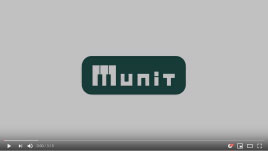 ジャズ作曲家、挾間美帆、CD制作助成
ジャズ作曲家、挾間美帆、CD制作助成
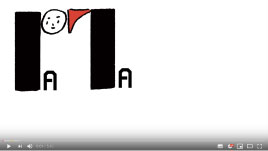 音楽家、網守将平、CD・コンサート制作助成
音楽家、網守将平、CD・コンサート制作助成
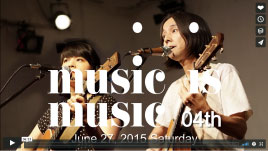 音楽プロデューサー、牧村憲一によるコンサート、レクチャー・シリーズの制作
音楽プロデューサー、牧村憲一によるコンサート、レクチャー・シリーズの制作
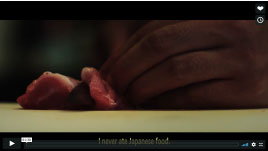 和食を世界各地の子供に食べてもらうショート・ムービー“オマカセ・フォー・キッズ”の制作
和食を世界各地の子供に食べてもらうショート・ムービー“オマカセ・フォー・キッズ”の制作